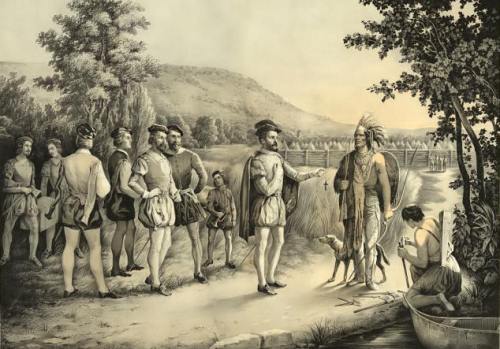Annotation:Reel Stadacona: Difference between revisions
No edit summary |
No edit summary |
||
| Line 14: | Line 14: | ||
<br> | <br> | ||
[[File:cartier2.jpg|550px|thumb|left|]]Stadacona was the name of an Iroguoian village on the St. Lawrence river that sheltered French explorer Jaques Cartier in 1534, who repaid them by capturing two of the chief's sons (Taignoagny and Domagaya) and forcing then to 'visit' France with him on his return voyage. Cartier did keep his word to return them, however, and they were reunited with the chief on Cartier's 1535-1537 voyage. The French overstayed the winter there, but their European diseases caught hold and killed some fifty villagers; meanwhile, the Iroquois assisted Cartier and his crew with a native preventative for scurvy, which had killed a a quarter of his men. Cartier again seized ten Native Americans for his return home. Unfortunately, none returned home this time. When Cartier came back to Quebec in 1543 he found the village destroyed and abandoned, the whereabouts of the inhabitants unknown. However, Cartier chose the location of the village to establish his colony of l'Habitation, which became the city of Quebec in 1608. | [[File:cartier2.jpg|550px|thumb|left|]]Stadacona was the name of an Iroguoian village on the St. Lawrence river that sheltered French explorer Jaques Cartier in 1534, who repaid them by capturing two of the chief's sons (Taignoagny and Domagaya) and forcing then to 'visit' France with him on his return voyage. Cartier did keep his word to return them, however, and they were reunited with the chief on Cartier's 1535-1537 voyage. The French overstayed the winter there, but their European diseases caught hold and killed some fifty villagers; meanwhile, the Iroquois assisted Cartier and his crew with a native preventative for scurvy, which had killed a a quarter of his men. Cartier again seized ten Native Americans for his return home. Unfortunately, none returned home this time. When Cartier came back to Quebec in 1543 he found the village destroyed and abandoned, the whereabouts of the inhabitants unknown. However, Cartier chose the location of the village to establish his colony of l'Habitation, which became the city of Quebec in 1608. | ||
<br> | |||
<br> | |||
Albert Allard and his Quatuor du Terroir ('the local quartet') recorded the tune as "[[Gigue des belles filles (La)]]" in Montreal in 1938. | |||
<br> | <br> | ||
</div> | </div> | ||
| Line 30: | Line 33: | ||
</font></p> | </font></p> | ||
<p><font face="sans-serif" size="2"> | <p><font face="sans-serif" size="2"> | ||
<font color=red>''Recorded sources'': </font> <font color=teal> - | <font color=red>''Recorded sources'': </font> <font color=teal> - Starr 16178 (78 RPM), Quatuor du Terroir (1938, as "La Gigue des belles filles"). </font> | ||
<br> | <br> | ||
<br> | <br> | ||
Revision as of 22:23, 13 June 2019
X:1 T:Reel Stadacona T:Smash the Windows S:Joseph Allard (1873-1947, Montreal, Quebec) L:1/8 M:6/8 N:Play slightly 'swung', not quite dotted eighth notes. D:Victor 263928A, Joseph Allard (1933) F:http://www.collectionscanada.ca/obj/m2/f7/13190.mp3 Z:Transcribed by Andrew Kuntz K:D DED F2A|d2f ecA|G2B F2A|E2F GFE| DED F2A|d2f ecA|Bgf edc|1d3 d3:|2d3 d2|| |:a|a2f f2d|A2a agf|g2e e2c|A2g ged| f2d g2e|a2f bag|fed eBc|1d3 d2:|2 d3d3||
REEL STADACONA. AKA and see "Gigue des belles filles (La)," "Roaring Jelly," "Smash the Windows." French-Canadian, Irish; Jig (6/8 time). D Major. Standard tuning (fiddle). AABB. "Reel Stadacona", a place-name in what is now Quebec City, is Joseph Allard's retitling of the Irish jig "Smash the Windows (AKA "Roaring Jelly]]"). Allard plays it without alteration, and with very few ornaments.

Albert Allard and his Quatuor du Terroir ('the local quartet') recorded the tune as "Gigue des belles filles (La)" in Montreal in 1938.
